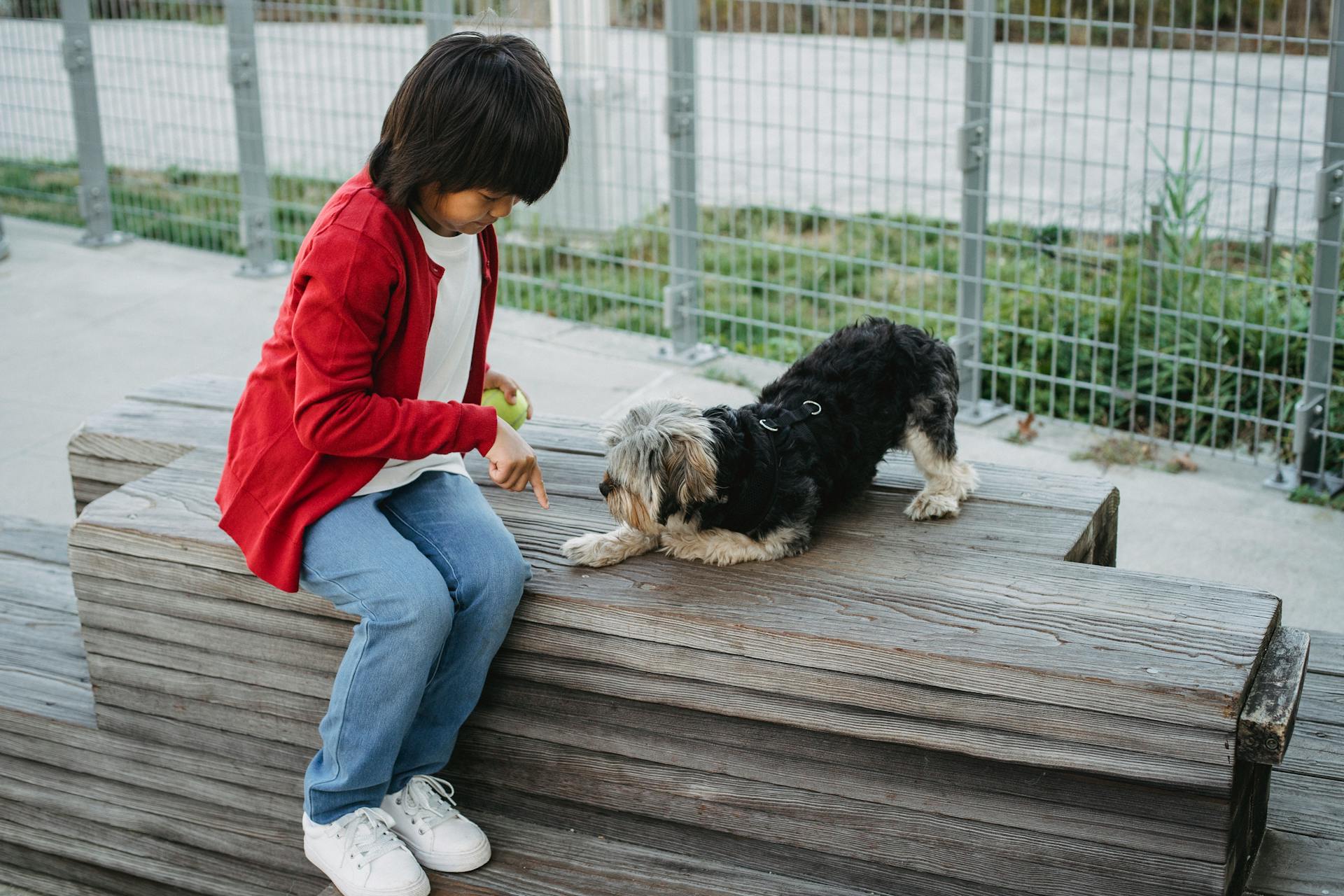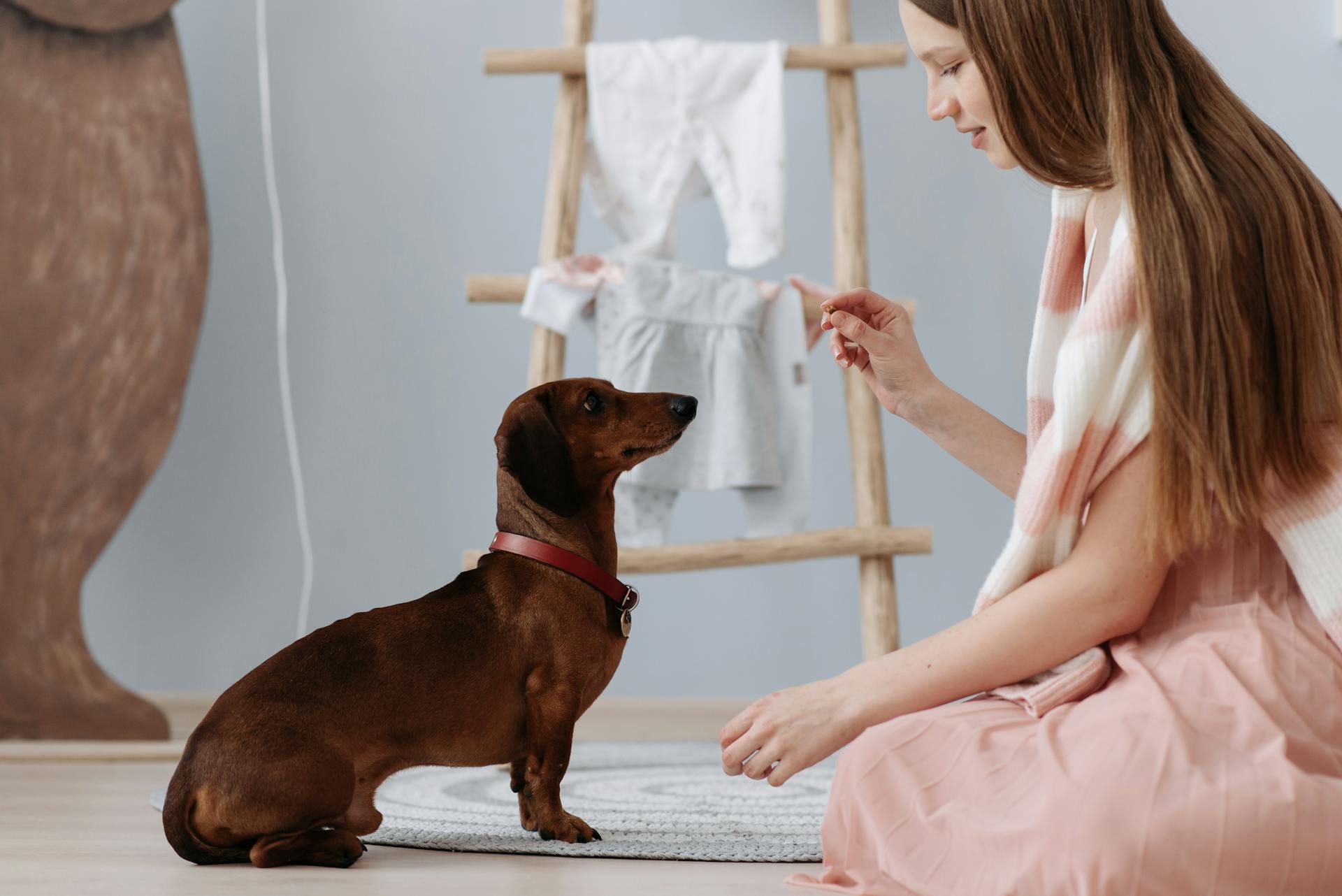
Desensitization dog training is all about helping your furry friend feel more comfortable in situations that might normally cause anxiety or stress. By gradually exposing them to these triggers, you can help them learn to cope and even enjoy time with you.
One of the key principles of desensitization training is to start with small, manageable steps. This is because overwhelming your dog with too much stimulation at once can actually make things worse.
For example, if your dog is afraid of loud noises, you might begin by simply sitting near a TV or radio that's playing at a low volume. Gradually increase the volume over time, rewarding your dog with treats and praise for remaining calm.
With patience and persistence, you can help your dog become more confident and calm in the face of triggers.
Additional reading: Calm Dog Training
Understanding Desensitization
Desensitization is a gradual process that helps your dog become comfortable with a particular stimulus, such as loud noises or strangers.
By exposing your dog to the stimulus at a low level, you can prevent overwhelming them and create a positive association.
This approach is especially helpful for dogs that have a history of anxiety or reactivity.
The goal of desensitization is to increase your dog's tolerance for the stimulus, allowing them to feel more relaxed and calm.
With patience and consistency, you can help your dog become more confident and secure in a variety of situations.
Desensitization can be applied to a range of stimuli, including sounds, sights, and even smells.
The key is to start with a low level of exposure and gradually increase it over time, allowing your dog to become comfortable with each step.
A unique perspective: Next Level Dog Training
Determine Your Dog's Triggers
Identifying your dog's triggers is a crucial step in desensitization dog training. It may take some observational skills on your part to understand what causes your dog to feel fear and anxiety.
Determine what the trigger is - is it a sound, smell, person, or object? This will help you create a plan to introduce your dog to the trigger in a way that won't cause them to be scared, aggressive, or fearful.
It's essential to understand the subtle signs of fear and anxiety in dogs to identify the true trigger. Sometimes, a dog will show subtle signs that then escalate and appear to be in reaction to something that is actually not the trigger.
For example, if a dog is nervous about the mailman but then seems to bark and become aggressive toward a housemate or person in the house, you need to identify the very first symptoms of fear and anxiety and retrain to that trigger.
By understanding your dog's unique triggers, you can begin the training process and help them feel more confident and calm in the presence of the trigger.
Explore further: Fear Aggression Dog Training
Creating a Plan
Creating a plan for desensitization dog training is crucial for success. It's essential to break down the process into manageable levels.
Start by creating levels, which will depend on the issue, dog's temperament, and other factors. The most important factor in each level is the distance, so reduce the distance to the stimulus by about 5 feet once your dog appears comfortable. If your dog reacts fearfully, go back to the previous successful distance and try again using half of the new distance.
Worth a look: Dog Training Levels
Organize your environment to ensure your dog is not exposed to triggering stimuli outside of the training scenario. This will help you create a controlled rehabilitation environment.
To create situations for desensitization, you'll need to repeat exposures to the stimulus at a particular distance multiple times before progressing to the next level. This process requires patience and may need the assistance of other people.
Here are some key considerations for creating a plan:
- Create levels based on distance
- Organize the environment to prevent exposure to triggering stimuli
- Repeat exposures to the stimulus multiple times before progressing to the next level
- Work with a helper if needed, and be patient
Create a Plan
Creating a plan is crucial when it comes to helping your dog overcome their fears and anxieties. It's essential to start small and be patient, as rushing through the process can be counterproductive.
To create a plan, you need to determine the number of levels your dog will need, which will depend on their temperament and the issue at hand. The most important factor in each level is the distance from the stimulus. You should start with a comfortable distance and gradually reduce it by about 5 feet.
See what others are reading: Dog Training Business

Organizing the environment is also crucial. You need to plan your routine and environment in a way that your dog won't be exposed to the triggering stimulus, which can bring about responses of fear or anxiety. This means creating a controlled rehabilitation scenario where your dog can learn to associate the stimulus with something positive.
Desensitization is a form of classical conditioning that requires repetition. You need to create situations where your dog will be exposed to the concerned stimulus at a particular distance for a number of times before progressing to the next level. This process consumes a significant amount of time and may require the assistance of other people.
Here are some key factors to consider when creating a plan:
By following these steps and being patient, you can help your dog overcome their fears and anxieties and live a happier, healthier life.
Selecting a Trainer
Choosing a trainer is a crucial step in creating a plan, and it's essential to consider their qualifications and experience. A trainer with a certification in a specific area, such as a Certified Strength and Conditioning Specialist (CSCS), can provide expert guidance.
For example, a trainer with a CSCS certification can design a workout plan that incorporates strength training and conditioning exercises to improve athletic performance. A trainer with a CSCS certification is qualified to design a workout plan that incorporates strength training and conditioning exercises.
Consider a trainer's experience working with clients with similar goals or needs as yours. A trainer with experience working with clients who have similar fitness goals or health conditions can provide tailored guidance and support.
For instance, a trainer with experience working with clients with chronic pain can design a workout plan that incorporates exercises that are gentle on the joints and promote flexibility. This can be particularly helpful for individuals who have chronic pain or injuries that limit their mobility.
Ultimately, the right trainer for you will depend on your specific needs and goals. Be sure to research and interview potential trainers to find the best fit.
You might enjoy: Operant Dog Training
Training Techniques
Behavior modification techniques can be learned and used as preventive measures, but they do require a regular investment of time and effort.
Most of these techniques are not hard to learn and can be successfully used to change your dog's behavior.
Consistency and patience are key when using desensitization and counterconditioning techniques, as it may take longer for some dogs to unlearn what they've been conditioned into.
Desensitization and counterconditioning can be used to make positive changes in your dog's behavior, even if it takes time.
Rewards and Motivation
Dogs prefer to receive petting over verbal praise or treats, and respond more quickly when they expect it.
Test different rewards for your dog, as some may do anything for a bit of freshly-cooked chicken, while others might prefer a tummy-rub.
You might choose a reward to suit the situation, such as allowing your dog to greet a visitor after they've sat down nicely on command.
It's essential to use rewards that your dog finds motivating, as this will help them associate good behavior with a positive outcome.
Verbal praise, petting, and treats can all be effective rewards, but it's crucial to find what works best for your dog.
As you progress with desensitization training, you can use rewards like your dog's favorite toy or an extra-special treat to motivate them.
Remember, the goal is to keep things positive and rewarding, as scolding or punishing your dog can actually make their behavior worse.
Check this out: It's Your Choice Dog Training
Seeking Professional Help
If you're struggling with desensitization dog training, it's essential to seek professional help. A professional dog trainer can help you develop a customized training plan that suits your dog's unique needs and personality.
Desensitization training requires patience, consistency, and a deep understanding of canine behavior. This is why working with a professional is crucial, especially if you're new to dog training.
A professional trainer can help you identify the underlying causes of your dog's fears and phobias, such as loud noises or strangers. They can also teach you how to create a safe and controlled environment for training.
Suggestion: Does Getting a Dog Fixed Help with Aggression
Desensitization training typically involves gradual exposure to the feared stimulus, starting from a safe distance or intensity. This allows your dog to become comfortable with the stimulus at its own pace.
With the right guidance and support, you can help your dog overcome its fears and become a confident, well-behaved companion.
Related reading: When Do Cane Corsos Become Protective
Frequently Asked Questions
What is the difference between counter conditioning and desensitization?
Counter conditioning pairs a feared stimulus with a positive association, while desensitization involves gradual exposure to the feared stimulus to reduce its impact
Sources
- https://www.caninescholars.com/dog-training-methods/systematic-desensitization/
- https://www.merckvetmanual.com/dog-owners/behavior-of-dogs/behavior-modification-in-dogs
- https://www.animalhumanesociety.org/resource/counter-conditioning-and-desensitization
- https://www.thesprucepets.com/desensitization-and-counter-conditioning-dog-training-7368763
- https://fotp.com/learn/dog-training/what-is-dog-desensitization-training-and-counter-conditioning
Featured Images: pexels.com


